
Art Unlimited - Čiurlionis Gym
12–18 JUNE 2023
Special
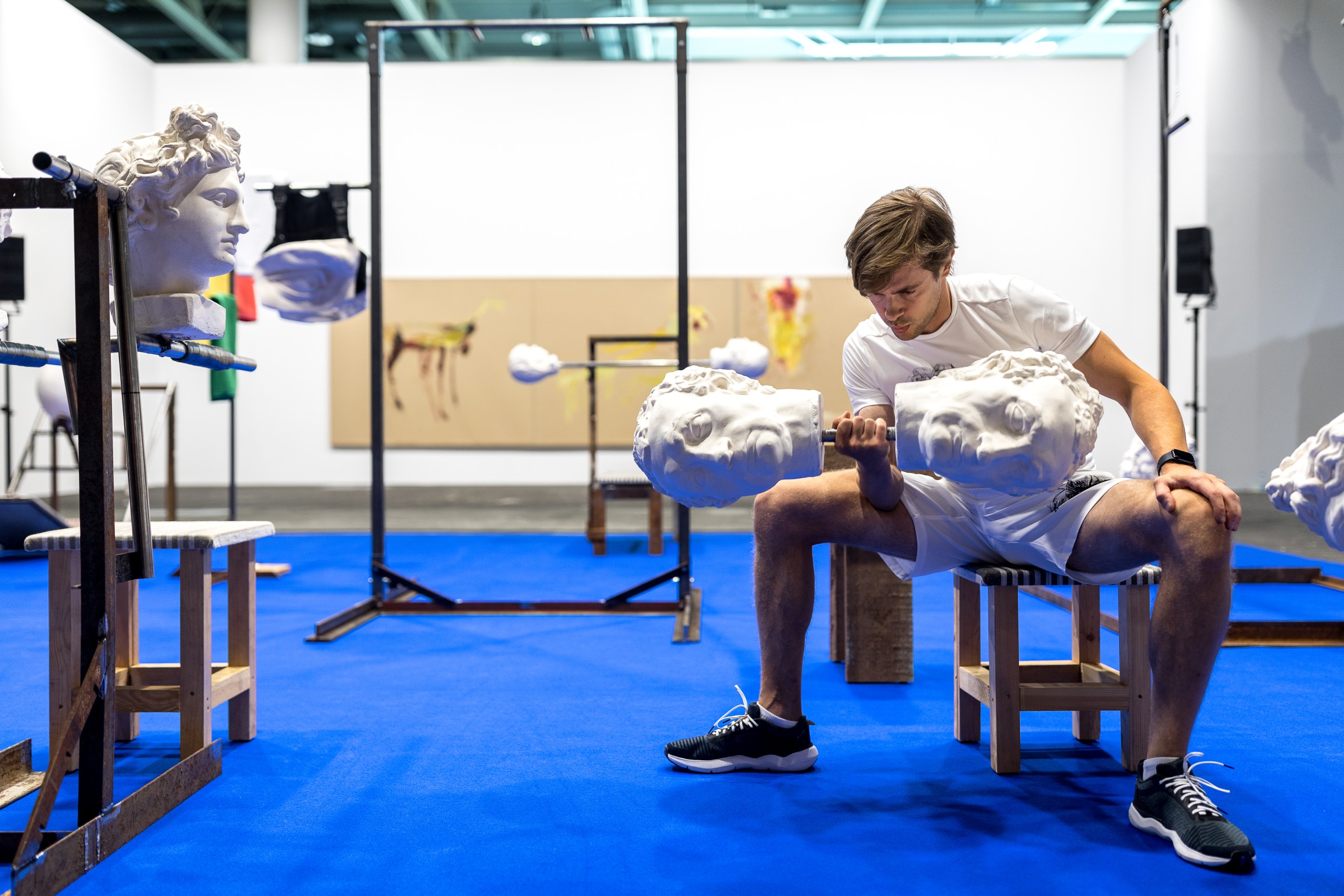
Augustas Serapinas tells stories of places, people and site specific memories in his installations. By removing the usual properties of specific spaces and objects and attributing new characteristics to them, Serapinas changes our previous perceptions. Through these spatial shifts, he rethinks (in-between) space as a public place and makes visible the institutional, hierarchical or even economic functions resulting from architectural conditions. In many of his works he engages with his country of origin and illuminates facets of Lithuania’s geography, history and culture in subtle and humorous ways. Serapinas’ artistic work is characterized by a spontaneous and above all intense engagement with his immediate surroundings. He often works with people from the neighbourhood and actively involves them in the process of creating his work.
Serapinas uses found materials, such as snow, mud and hay, borrowed objects such as the property of residents in the direct vicinity of the exhibition space and materials purchased at auction such as wooden barns from rural areas or fragments from the wall of a decommissioned nuclear power station. For his first exhibition in the Chesa Madalena in Zuoz, Five Stoves, he acquired five former tiled stoves dating to the late 19th and early 20th centuries. He converted these stoves, which at the time represented an integral and essential part of domestic interiors, into contemporary objects of utility. They can no longer be used for their actual function of heating, but parts of the stoves are still preserved in their original condition. If we shift our perspective, the new function assigned to them by Serapinas becomes apparent in the form of a table or another household object. Serapinas doesn’t just change the property but also the aesthetics of the object and thus directs the focus to the social and political changes in domestic living space.
Augustas Serapinas graduated from the Vilnius Academy of Arts in 2013 and subsequently completed the Rupert Educational Program in Vilnius. His work has been part of numerous biennials and group exhibitions, including the 57th Biennale di Venezia, Riboca2 and steirischer herbst22. In addition, his work has been shown in solo exhibitions, for example, at Kunsthalle Wien, SALTS in Birsfelden and CCA in Tel Aviv. Serapinas was awarded ‘Best Artistic Debut of the Year’ by the Lithuanian Ministry of Culture in 2014. In 2019, he held the Artist-in-Residency Fogo Island Arts (FIA) in Canada. His work is already represented in renowned public collections such as the Pinakothek der Moderne in Munich, M HKA, Museum of Contemporary Art Antwerp, Tate and Centre Pompidou.
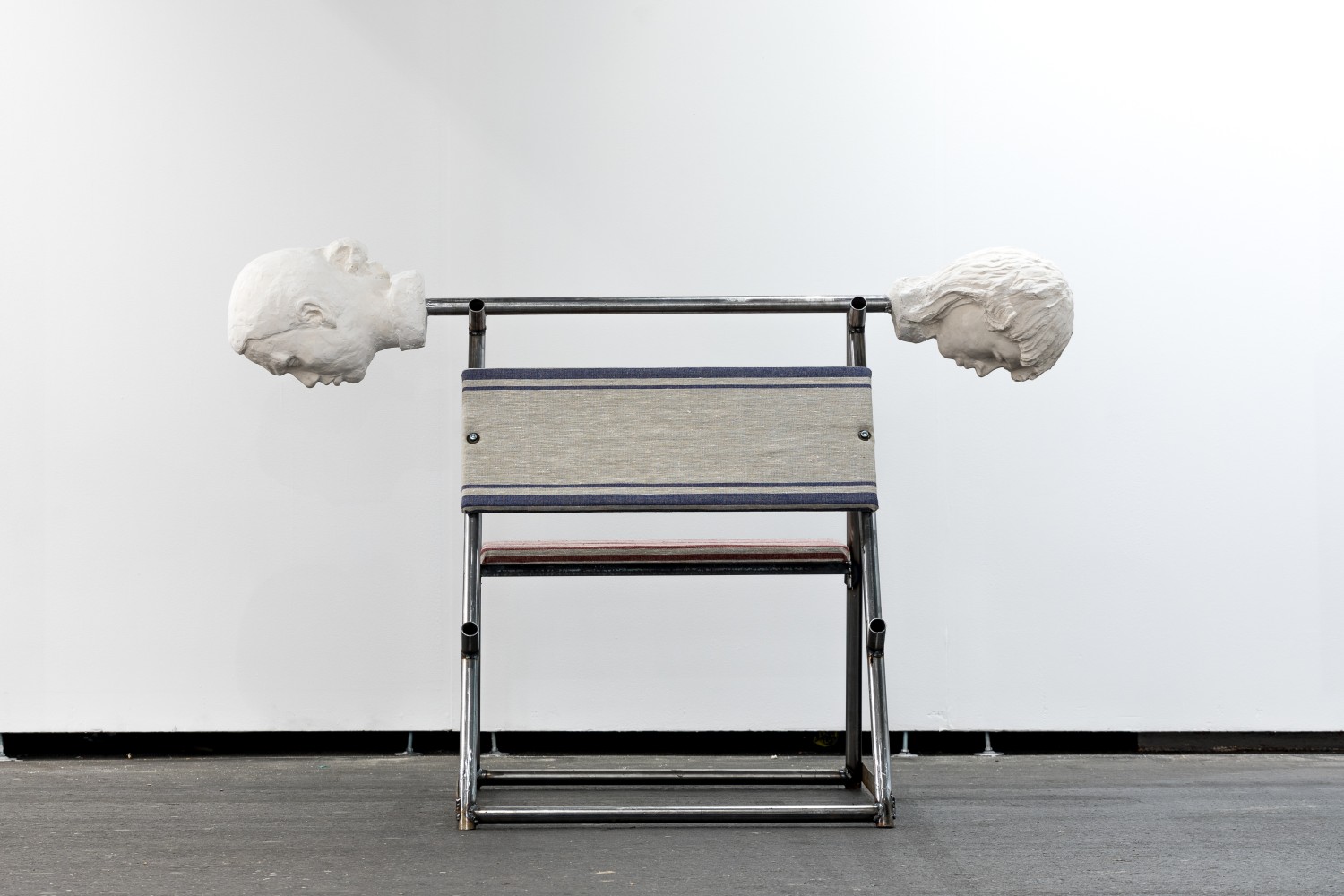
1/12
Metal, wire, plaster, wood, towel rack, table, felt, rope, linen
100 × 158 × 100 cm
AS/S 40

2/12
Installation view Art Unlimited
Courtesy of artist and Galerie Tschudi in collaboration with ApalazzoGallery
Photo: Nicolas Gysin
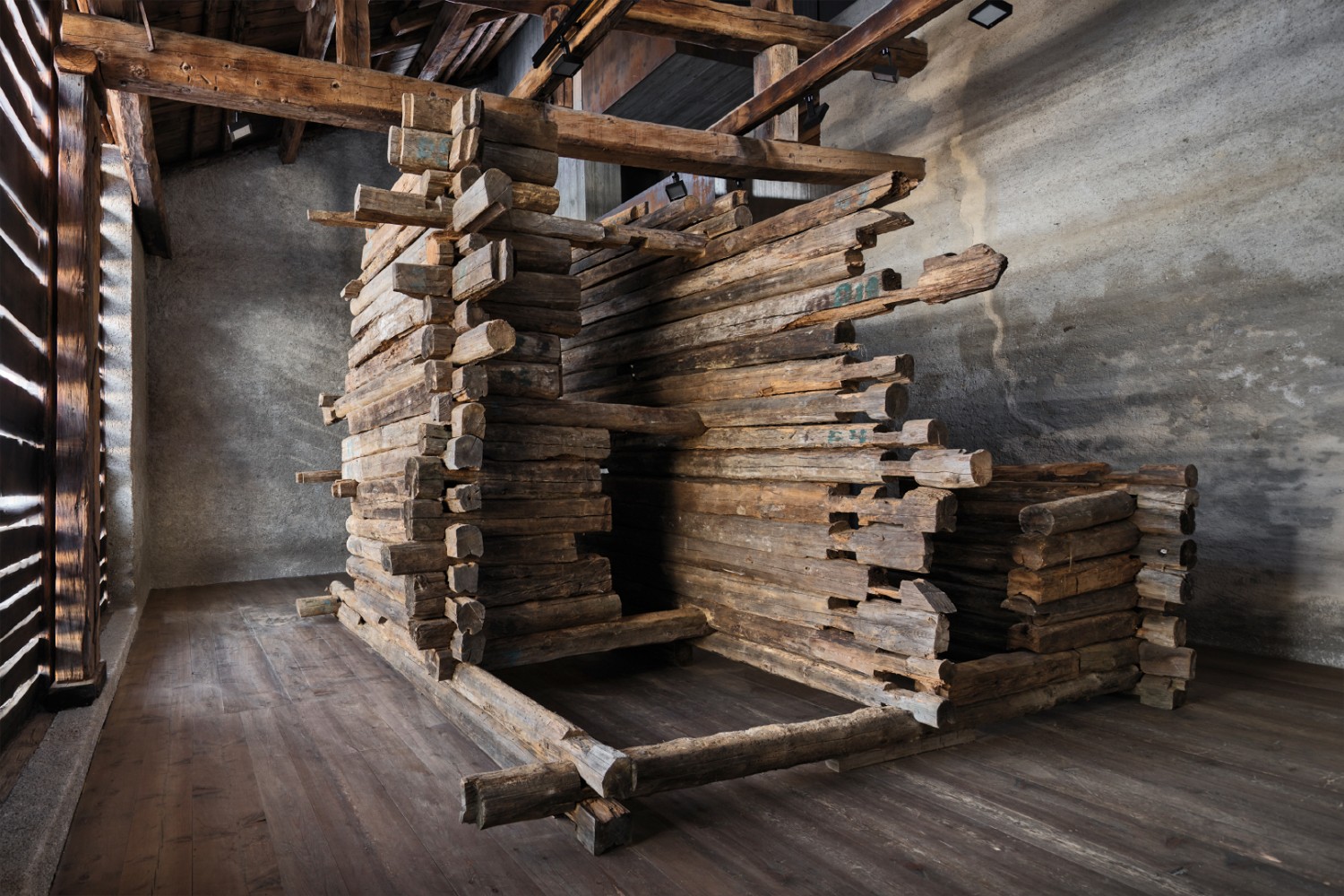
3/12
reclaimed wood
370 × 480 × 500 cm
AS/S 13
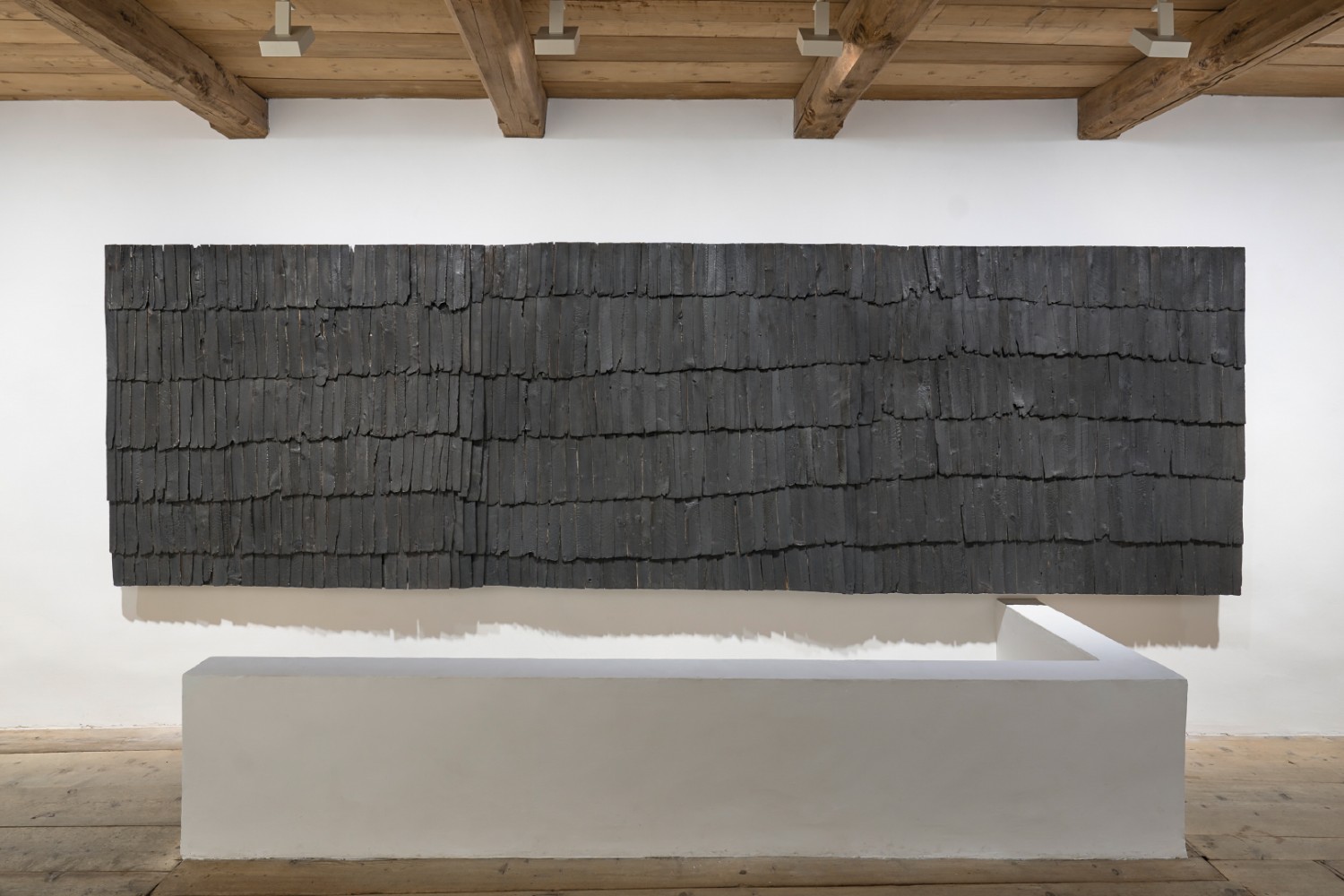
4/12
charred reclaimed wooden shingle roof
185 × 625 × 24 cm
AS/P 12
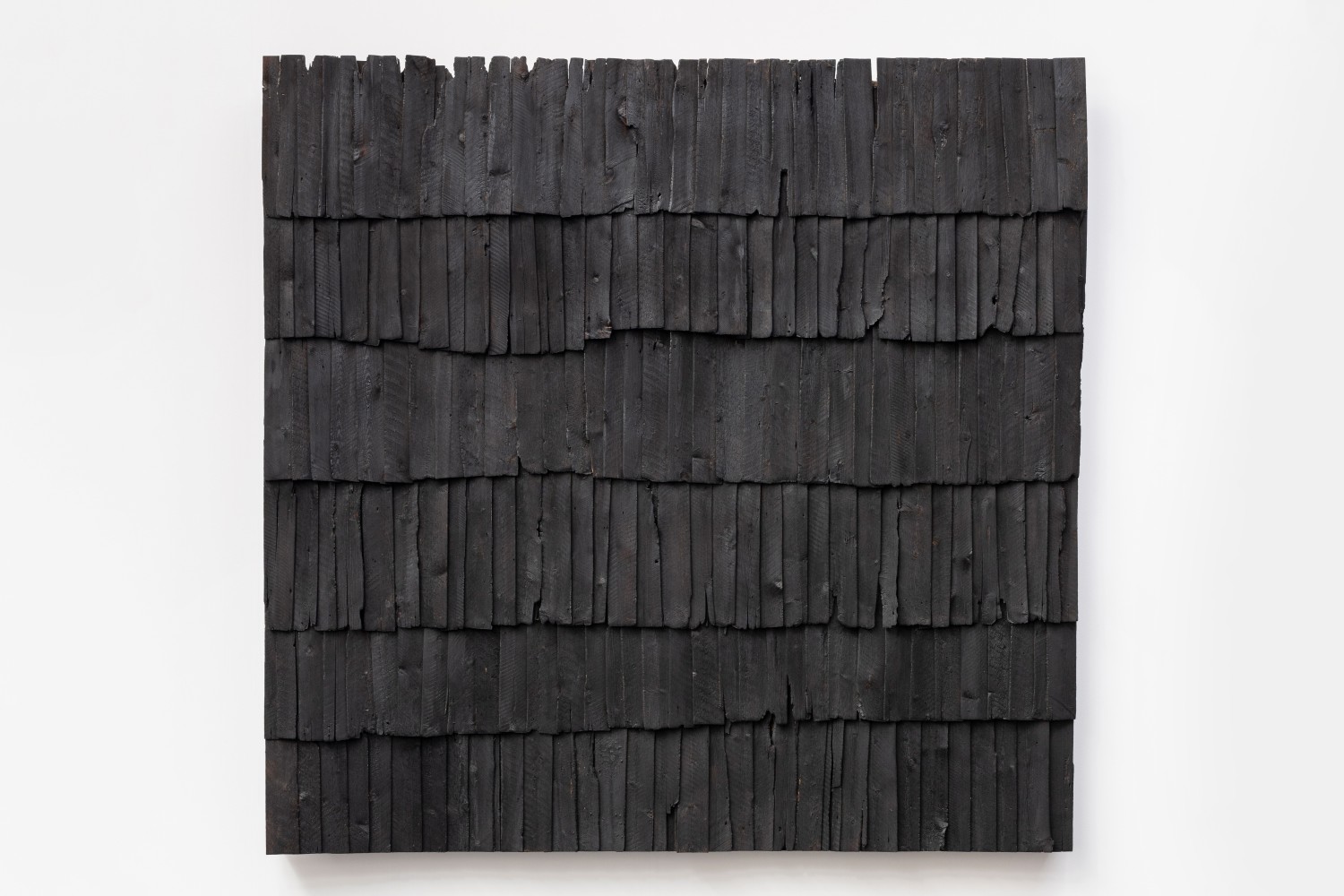
5/12
charred reclaimed wood, nails
180 × 190 × 12 cm
AS/P 3
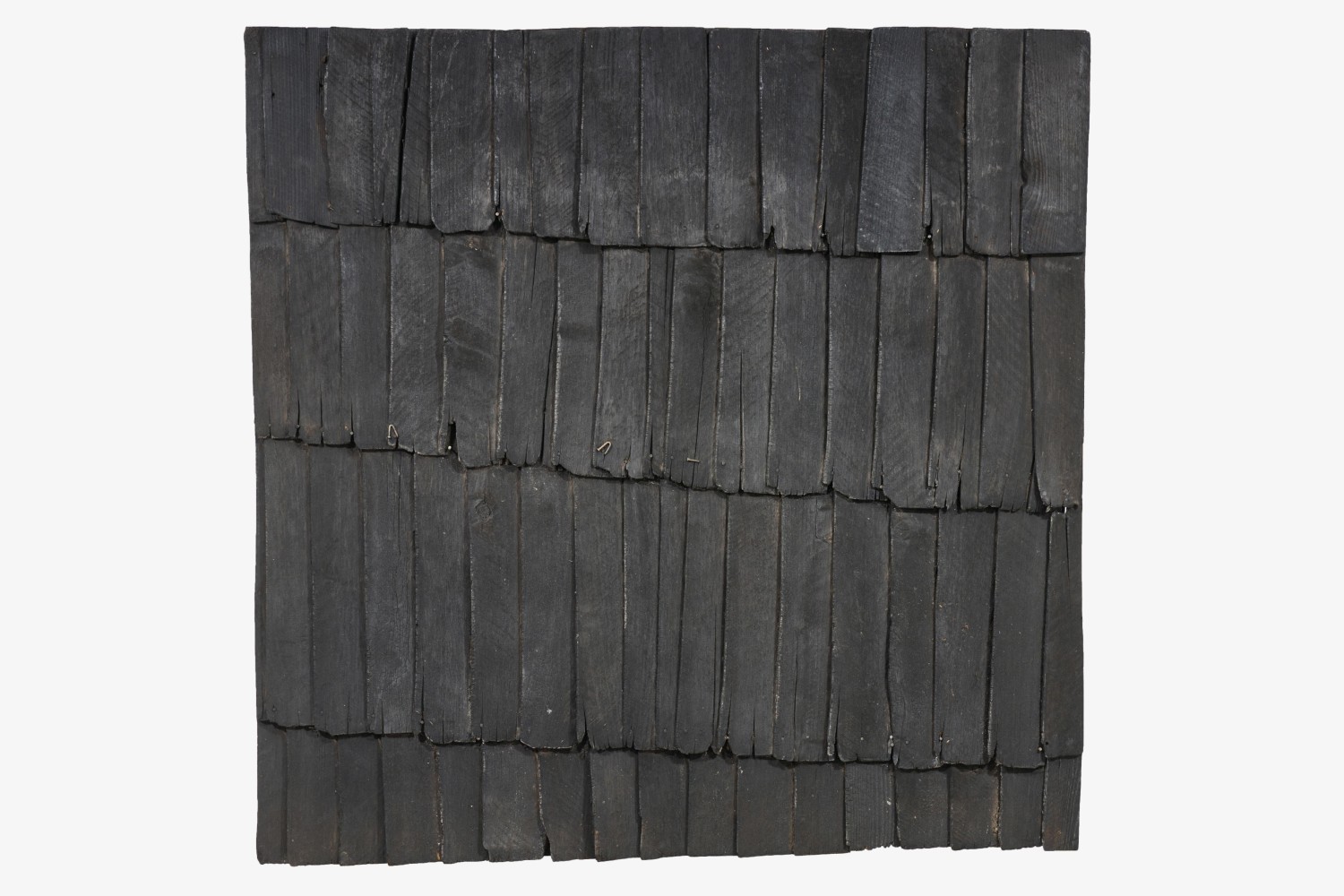
6/12
charred reclaimed wooden shingle roof
102 × 102 × 9 cm
AS/P 22

7/12
reclaimed wood
102 × 85 × 3.5 cm
AS/P 9
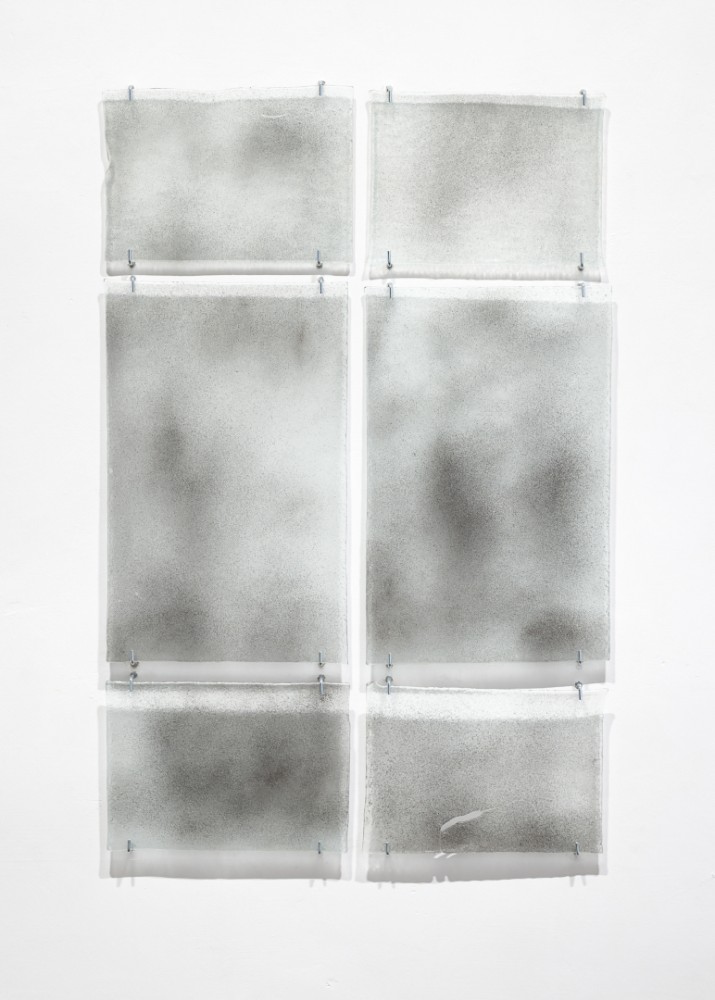
8/12
window glasses with old nails powder
90 × 59 × 0.5 cm
AS/P 15
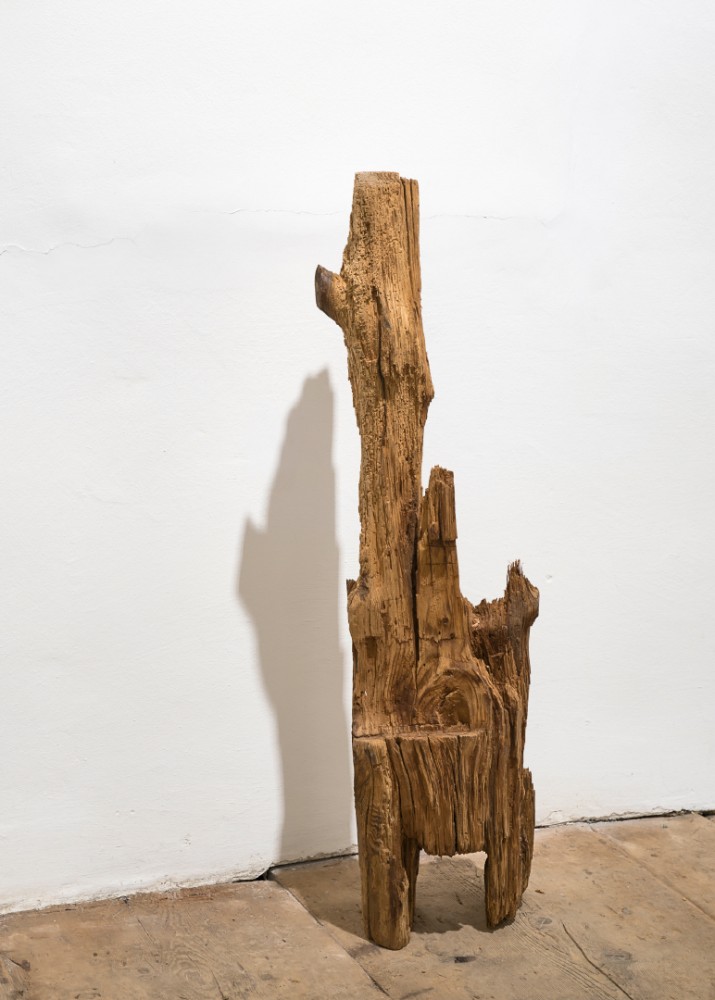
9/12
reclaimed wood
82 × 20 × 18 cm
AS/S 30
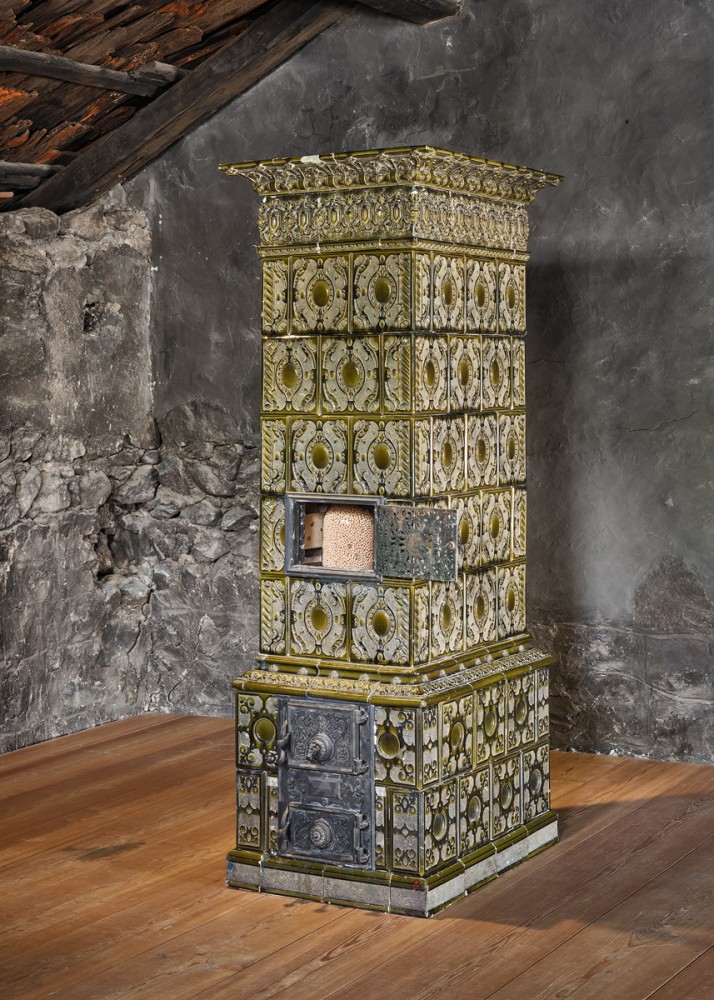
10/12
tiles, wood and grains
200 × 68 × 87 cm
AS/S 3
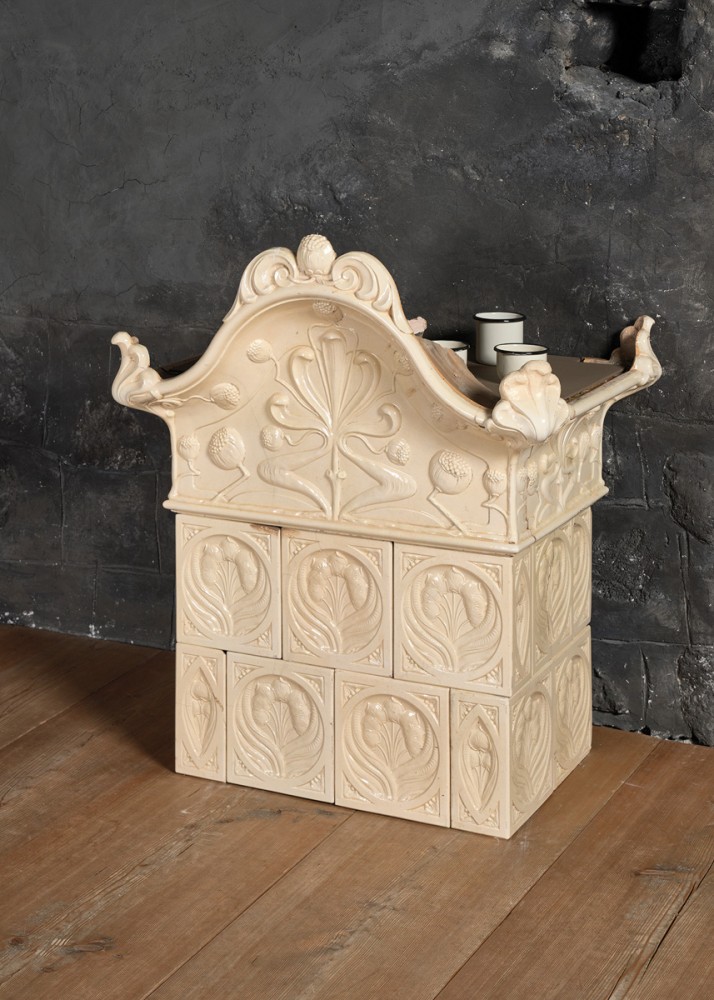
11/12
tiles, wood and teacups
93 × 80 × 59 cm
AS/S 7
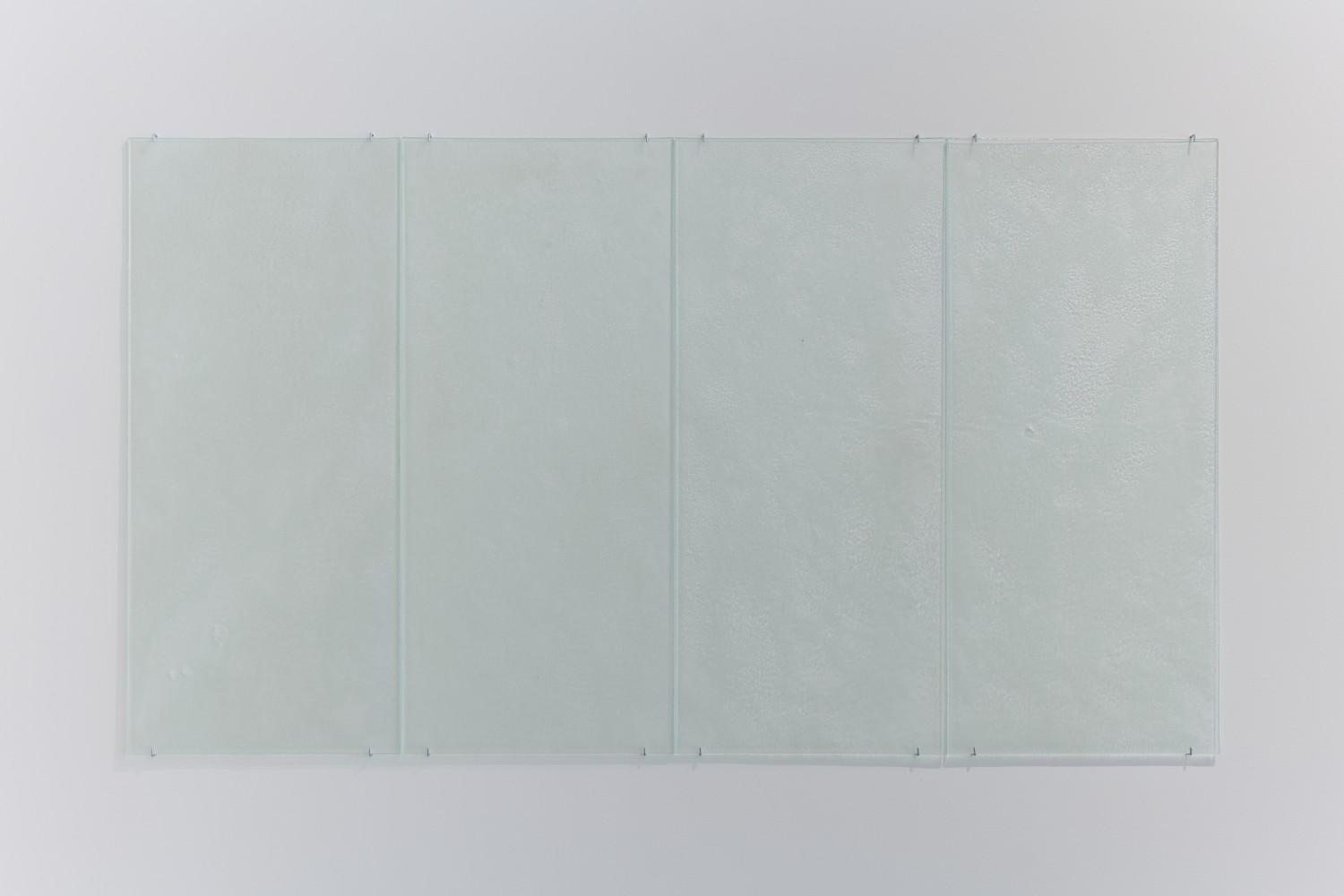
12/12
glass, ash
91.5 × 161 cm
AS/P 7
Group show
Compton Verney, Warwickshire
21.03.2024–02.05.2027
Compton VerneyGroup show
Bündner Kunstmuseum, Chur
24.02.–28.07.2024
Bündner KunstmuseumFOROF – a space dedicated to the dialogue between contemporary art and archaeology
03.10.2023–30.06.2024
ForofBeate Scheder
31 August 2023
Leer stehende Holzhäuser aus der litauischen Provinz dienen Augustas Serapinas als Material. Die Klosterruine zeigt „Roof from Rūdninkai“.
Khabir Jhala
13 June 2023
Augustas Serapinas creates the ultimate Art Basel workout using plaster cast pieces.
Maximiliano Duron
June 2023
Augustas Serapinas has taken The Greco-Roman artistic inspiration one step further by creating a functional gym as a durational performance piece and installation.
Maximiliano Duron
June 2023
Each year, Art Basel opens its week-long takeover of this Swiss city, not with the main event, but with its Unlimited section, dedicated to large-scale works or ones that require longer contemplation than a small art fair booth will typically allow. Unlimited, which this year boasts 76 projects, has a reputation for being a romp, and this year is no exception.
Below, a look at some of the best and wildest works on view in Unlimited.
Augustas Serapinas, Čiurlionis Gym, 2023
Since the Renaissance, artists have long looked back at Greco-Roman artistic traditions for inspiration. The men in marble sculptures, for instance, were often sculpted to be the pinnacle of bodily perfection: chiseled abs, bulging biceps and calves, and bubble butts. Augustas Serapinas has taken that inspiration one step further by creating a functional gym as a durational performance piece and installation. At certain points during the day, very in-shape men will take to Čiurlionis Gym and do a few sets of pull-ups, bicep curls, or leg presses. This is a powerful, tongue-in-cheek contemplation on the repetition and discipline needed to maintain such a body that the Greeks would have deemed worthy of being depicted in art—and the technical skill and draftsmanship needed to render that body perfectly.
Funda Karayel
June 2023
The 2023 edition of Art Basel has mesmerized art enthusiasts with its breathtaking displays and groundbreaking artworks.
Funda Karayel
June 2023
The 2023 edition of Art Basel has mesmerized art enthusiasts with its breathtaking displays and groundbreaking artworks.
With its unrivaled reputation as one of the world's premier art fairs, Art Basel has once again exceeded expectations, showcasing many extraordinary highlights.
Art Basel's marquee June fair in Switzerland has successfully brought together 284 galleries from 36 countries, creating a diverse and vibrant artistic showcase. With its preview on June 13, this edition marks the debut of new CEO Noah Horowitz, who assumed the role at the start of the year, succeeding Marc Spiegler. The event promises a fresh perspective under Horowitz's leadership while maintaining the prestigious reputation that Art Basel has cultivated over the years.
Ciurlionis Gym
Among the numerous exhibits, the Ciurlionis Gym installation by artist Augustas Serapinas stood out as a captivating and physically demanding performance piece. I enjoyed discussing this unique work with my art collector friend, Berrin Saran, who shared her firsthand experience of the Unlimited opening event held in Basel.
The Ciurlionis Gym installation profoundly explores the artistic process, physical endurance, and the intersection of art and fitness. Serapinas, a graduate of the Lithuanian university Ciurlionis, cleverly named the work after his alma mater, emphasizing the connection between the repetitive training artists undergo in art school and the dedication required for physical training. Art collector Berrin highlighted how the innovative use of plaster artworks as weights in Ciurlionis Gym challenges conventional notions of strength and beauty, effectively blurring the boundaries between art and fitness.
Katja Richard & Stefan Bohrer
13 June 2023
Gigantische Werke, die höchsten Preise und die schrägste Kunst: Heute hat die Art Basel ihre Tore fürs auserwählte Publikum geöffnet.
Katja Richard & Stefan Bohrer
13 June 2023
Die Art Basel ist die wichtigste Kunstmesse der Welt. Nur Auserkorene drängeln sich am ersten Tag in den Ausstellungshallen. Doch auch Blick konnte gemeinsam mit Galeristinnen, Kuratoren, Käuferinnen vorab ein Auge springen lassen. Diese Werke sind aufgefallen.
Das Sportlichste
Ein Fitness-Studio erwartet die Gäste an der Unlimited-Eröffnung: Der Künstler Augustas Serapinas lässt im Čiurlionis Gym (2023) Profis für eine jeweils 30- minütige Performance trainieren. Statt mit normalen Geräten werden Gewichte aus griechischen Götterfiguren gestemmt. Diese wiegen immerhin drei bis acht Kilogramm. Keine Sorge: Besuchern wird kein Training abverlangt, Aufführungen finden täglich statt.
June 2023
285 Galerien aus 36 Ländern stellen ab heute drei Tage lang auf der Art Basel aus.
Vom 15. bis 18. Juni Fndet in Basel die Art Basel 2023 statt, eine der weltweit bedeutendsten Kunstveranstaltungen. Mit insgesamt 285 Galerien aus 36 Ländern verspricht die Messe ein beeindruckendes Erlebnis für zehntausende Kunstfans. Unter den teilnehmenden Galerien sind dieses Jahr sechs renommierte Wiener Galerien: Croy Nielsen, Gregor Podnar, Martin Janda, Galerie Krinzinger, Layr, und Galerie nächst St. Stephan Rosemarie Schwarzwälder.
Die Art Basel bietet Besuchern, Sammlern und Künstlern erneut eine vielfältige Plattform für zeitgenössische Kunst. Auch "Heute"- Herausgeberin Eva Dichand war vor Ort und durfte, noch vor der o_ziellen Eröffnung, die internationale Kunstmesse besuchen. Von Malerei und Skulptur über FotograFe bis hin zu Installationen und Performance-Kunst gibt es heuer eine breite Palette an skurrilen, beeindruckenden und außergewöhnlichen Werken zu entdecken.
Roger Federer hängt nackt von der Decke
Eine weitere faszinierende Installation, die auf der Messe zu sehen ist, ist "Čiurlionis Gym (2023)" vom Künstler Augustas Serapinas. In dieser skurrilen Performance stemmen ProFs, in einem nachgebauten Fitnessstudio, für jeweils 30 Minuten griechische GötterFguren, was einen interessanten Kontrast zwischen antiker Mythologie und zeitgenössischer Kunst schafft.
Um beim Sport zu bleiben: Für Tennis-Fans gibt es ein besonderes Schmankerl. Denn für die von der Decke hängende Statue von Ugo Rondinone stand Tennis-Star Roger Federer halbnackt Modell. Die Federer-Skulptur gibt es auf der Messe für rund 360.000 Dollar zu kaufen.
Die größte Veränderung bei der diesjährigen Messe ist wohl der Führungswechsel. Noah Horowitz ist neuer CEO der Art Basel und löst damit Marc Spiegler ab. Horowitz steht Vincenzo de Bellis zur Seit. Als Direktor für Messen und Ausstellungsplattformen verantwortet er die vier Messen der Art Basel.
1 March 2023
A conversation on traditional materials, architectural fragments, site specificity and new perspectives found when looking with fresh eyes towards the un-seen.
1 March 2023
Heritage is a malleable thing, its meaning always shifting between present use and past significance. Closely tied to notions of identity and place, vernacular architecture is, nonetheless, often at odds in its relationship to contemporary art and architecture practices. But, what happens when these same approaches are used to preserve vernacular tradition? What can we learn about our past if we allow the fragments of history to perform in other contexts? In this interview, Lithuanian artist Augustas Serapinas talks about his relationship with built and un-built heritage, old Lithuanian wooden houses, architectural space and how his point of view gets informed by those of others.
KOOZ: The exhibition Wood and Snow at Galerie Tschudi can be seen as a direct continuation of your long-standing interest in the relationship between vernacular architecture and modern monumental sculpture. What informed this interest? How do you approach our built environment?
AUGUSTAS SERAPINAS: In 2016, I was in the Fogo Island Arts residency preparing an exhibition. There, I encountered a local shed which was soon to be demolished. Sheds in Fogo are part of local heritage, part of identity. Locals fix boats, salt fish and have shed parties. I reacted to that situation and managed to save the house and turned it into an artwork. I titled it Four Sheds because, while dismantling it, I learned from locals that it was altered three times before. In Fogo Island it was common practice to change the purpose of the shed and make alterations. After my experience in Canada, I turned my sight to Lithuania. We have a lot of old abandoned wooden buildings. Unfortunately, old wooden buildings are mainly protected in city centers and historically significant areas. Otherwise, these buildings are on their own. You can browse online to find such houses on sale for firewood, materials. More buildings are not even listed and just left to decay. In 50 years, when they become scarce, they will officially become a cultural heritage, but not now.
My first works from Lithuania were made with materials from a house near Prienai. The owner wanted to demolish it but I took it first. Since the house was already roofless and partly rotten, I cut it in pieces, then treated those pieces against bugs and mold and put them on display in exhibitions. Paradoxically, in most cases, I destroy these wooden buildings myself. However, I only take those which I know will be gone anyway. Through deconstruction, I show these houses from another perspective. Parts of wooden walls, windows, roofs—in a way it is all about the beauty of craftsmanship. I find quality in details, patterns, materials, colours. The house turns into sculptures and each sculpture becomes an ambassador for the regional vernacular wooden architecture.
KOOZ: Specifically, the exhibition in Zuoz consists of variations of sculptural compositions, built from elements of abandoned and decaying wooden houses which would have otherwise been purchased to be used as firewood. What questions does the exhibition seek to raise and address?
AS: I have always been fascinated by space, how it can affect our activities and perception. The same task in two different spaces might have slightly different outcomes. If we had met for this interview at a high-ceiling loft with big windows, our conversation could have gone one way, but if we had the same meeting at a narrow underground tunnel it could have gone another way. This applies also to other things, artworks, for example. The same artwork in two different exhibitions can get different context because of the space’s history and theinterior, surrounding works. With artworks there is another thing as well—the same work can be installed in a better or worse way. Space and surroundings have a big impact. I always have that in mind while preparing and installing my exhibitions. In some cases, the site and context specificity becomes a big part of the work, but I never neglect the installation itself as well.
In Zuoz, I brought wooden houses keeping in mind the Tschudi gallery space itself. All these wooden remains of the houses were brought to highlight the wooden elements of the Tschudi gallery space—a medieval Swiss alpine house in Zuoz. It is a dialogue between two different house building traditions. On the other hand, the exhibition is about Lithuanian wooden houses. There is deliberately no fully assembled house on display, even when we could build not one, but two whole houses if we were to use all the available pieces. There is a volume of elements that speaks about vernacular architecture without showing any architecture. I am more interested in this particularity and what makes it possible. The show is a review of such elements, their composition and patterns.
KOOZ: Beyond the space of the gallery, you very frequently also operate within open public spaces with site specific works. How do the sites in which you operate either as commercial private endeavors or publicly accessible open spaces define the artwork produced and exhibited within these? How do you approach site specificity?
AS: Every site, every situation is a unique set of things. I like to enter such situations through local people. I create my view with the help of others. A cleaner at the bank might give more interesting insights than the public relations manager. I titled a lot of artworks after people's names who were essential for their development. Also, sometimes I am interested in hidden spaces. A secret tea room in a business consulting headquarters sounds interesting, especially if it is fully functional and there are people to discover and use it.
I create my view with the help of others.
KOOZ: More than immersive works, your practice often engages the audience by redirecting their gaze to the un-built and unseen. How do you deploy your installations to foreground and uncover hidden dynamics of social hierarchy, economy, and memory?
AS: I often build my installations by trying to shift between the perspective of the artist and the viewer. That helps me to be aware of the viewer's gaze and construct the works accordingly. I am not sure if I am capable of working towards uncovering hidden dynamics directly through research. I rather notice paradoxes indicating it. It comes with my insights, sometimes mere coincidences.
KOOZ: How do you envision your work changing in the near future? Are there specific urgencies and topics which you are keen on focusing on? If so why?
AS: I have done a lot of visually different works and it feels nice to be able to work longer on one particular theme. It gives me the opportunity to look more into aesthetics. Having it in mind, I will keep enjoying working on wooden houses a little bit longer, looking for new expressions. And I will do it too with topics I touched before, particularly the gym and snow. But of course, the works related to space and context will not disappear from my practice. It is just harder to talk about it in future tense as it is more about immediate reflection to the given situation rather than pre-constituted ideas.
Marina Fuchs
1 February 2023
Die Zuozer Galerie Tschudi zeigt aktuell Arbeiten von Augustas Serapinas, Petra Wunderlich und Su-Mei Tse. Drei starke Einzelausstellungen, die sich ideal zusammenfügen.
Natalija Paunic
4 Februrary 2021
Lithuanian artist Augustas Serapinas talks exclusively for DSCENE Magazine’s Winter 2020.21 issue.
Auguste Petre
3 June 2019
"Augustas Serapinas, the youngest artist in the Venice Biennale,” reported nearly all of the art news portals when the list of the participants in the May You Live in Interesting Times exhibition curated by Ralph Rugoff was officially announced. Was this done with the intent to create a sensation? Not likely.
Guy Mackinnon-Little
2019
Lithuanian, born and based, Augustas Serapinas is an artist who works with curiosity and context, devising site-specific installations and uncovering rich human stories hidden just out of sight. His work is born of empathy and open-ended engagement. Most of Serapinas’s shows begin with a conversation with whoever happens to be nearby.
Travis Jeppesen
March 2017
Last Autumn, I was invited for a monthlong residency at the art and education center Rupert in Vilnius, Lithuania, where I got to know a number of key figures in the Baltic art scene, including some of the brightest up-and-comers. Among the latter is Augustas Serapinas (b. 1990), whose site-specific installations and actions have garnered much attention throughout Europe in recent years.
We are very sorry.
Unfortunately, your browser is too old to display our website properly and to use it safely.
If you are using Internet Explorer, we recommend updating to its successor Edge or switching to Firefox, Chrome or Brave. If you surf with Safari, we recommend updating or even switching to one of the above browsers.
Galerie Tschudi
Contact Page×